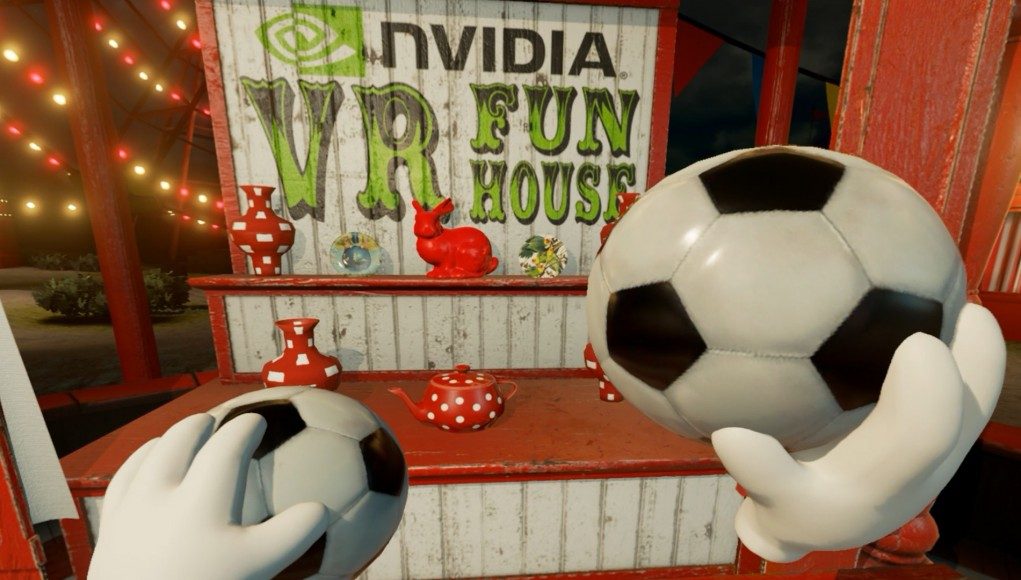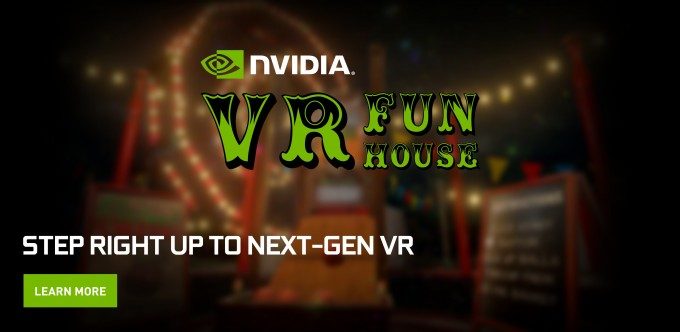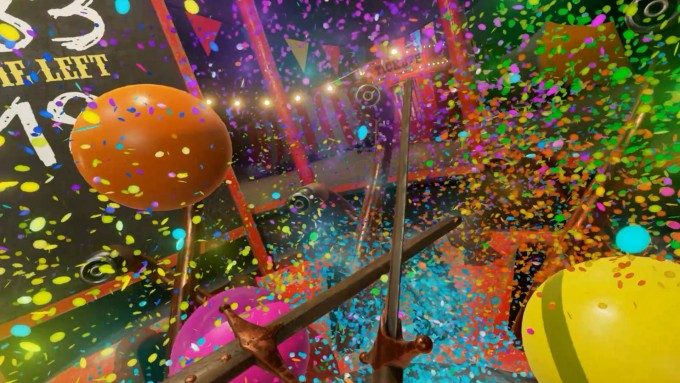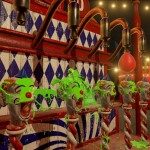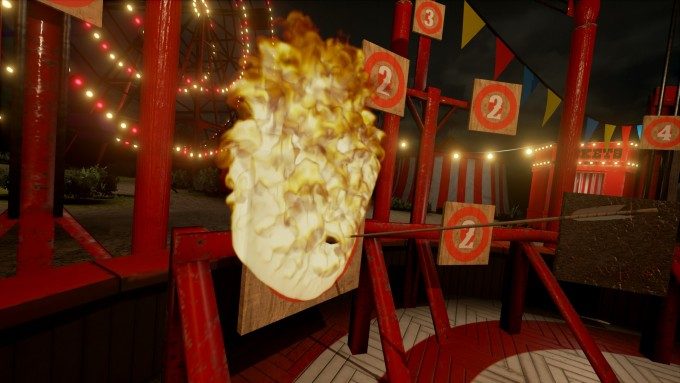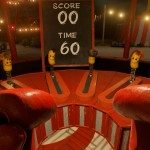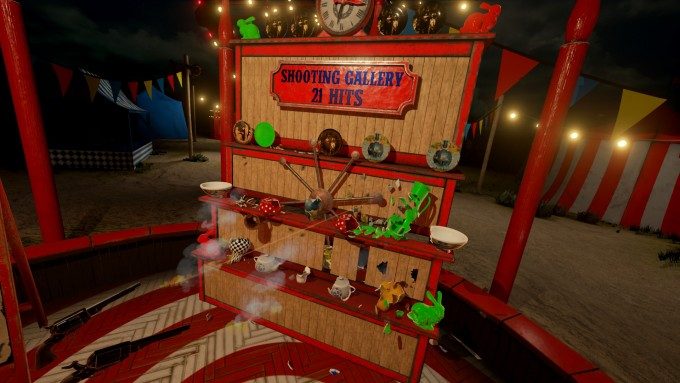Nvidia’s VR Funhouse is a virtual sandbox chasing reality, one designed to demonstrate how GPU accelerated physics can enhance presence in immersive environments. It’s released for free today on Steam, but is it any fun?
Perhaps it’s just my over exposure to horror tropes drawn from far too many Z-grade horror movies, but a traditional carnival environment, one seemingly devoid of human life is the last venue I’d choose for a relaxing, immersive diversion in my spare time. Just me? Probably. In any case, Nvidia clearly didn’t feel the same way as it’s the setting and premise of their latest collection of technical demos designed to show how the fusion of cutting edge GPU rendering and physics can significantly enhance immersion in virtual reality.
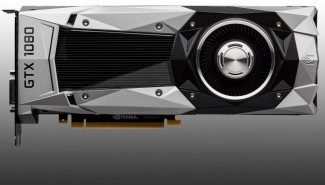
Developed by Nvidia’s Lightspeed Studios and built for the HTC Vive, the aim of VR Funhouse is to demonstrate the potential power of virtual reality and motion controls when the experience is driven by their new lines of Pascal GPUs – the GTX 1060, 1070 and 1080. To that end, VR Funhouse is packed to the brim with high resolution, CUDA powered physics simulating everything from realistic fluids to believable object destruction. What’s more, VR Funhouse also throws in some interesting experimental studies in haptics and object interaction, married to the visuals to push the envelope in selling the illusion of your physical interaction with virtual space and objects.
The Tech
VR Funhouse is developed by Nvidia’s own Lightspeed Studios and is a collection of mini games, each built using and showcasing different mixes of key Nvidia technologies which form part of the company’s ‘Gameworks’ suite of APIs. Here’s a quick rundown of some of the tech featured:
FleX: Nvidia’s particle simulation engine for the rendering of real-time, in-game visual effects, the company says that FleX uses a “unified particle representation for all object types,” which they claim “enables new effects where different simulated substances can interact with each other seamlessly.” In real terms, FleX is used in VR Funhouse to render the green gloop in the Clown Painter mini game for example.
Flow: Handling real-time combustible fluid, fire and smoke simulation. Flow handles the fiery arrows, flaming targets and braziers for example.
Hairworks: Hopefully self explanatory, you may well have come across hairworks in titles like The Witcher 3 and provides a way to render collections of individual hairs or fur which move in response to in-game forces. Check out the Whack-a-mole and Mole Boxing mini games for examples of this in action.
PhysX: Native Nvidia GPU general purpose physics system used from the simulation of bouncing balls to realistic cloth movement and object destruction. Check out the Shooting Gallery and Cannon Skeet mini games for some example.
So, that’s the tech, but does the application of it actually result in an experience worth checking out? I went hands on with the latest build of VR Funhouse, which will be available to everyone for free, from Steam, from today. These are my thoughts on each of the individual experiences.
The Games
Balloon Knight: Surrounds you with myriad multi-coloured balloons, and arms you with two lovingly rendered swords with which to dispatch them. The aim of the game is to pop as many as you can in the time limit, but as with balloons in real life – here modelled with surprising realism – you’ll need to gauge angle and swing (or simply poke at them) to deal with them swiftly. The balloons sprout from metal tubes and jostle for position, bouncing realistically off one another, with object boundaries fully respected (i.e. there’s no cheap clipping between objects happening here).
Every balloon burst showers you with confetti, here rendered using Nvidia’s FleX systems with every speck affected by other objects in the scene. Slowly swing your sword through the confetti and watch it cut a wake through the cloud. As an aside though, of all the demos here, this is the one that will make you look the most idiotic in real life. Demand phones are confiscated before playing front of friends because as it turns out, there’s no way to mete out manic metal destruction on these things without looking like a complete buffoon.
Cannon Skeet: You’re faced with a portly cannon which proceeds to slide from left to right and back, all the while firing random ceramic objects into the air – from teapots to china statues. You’re armed with two wild west style revolvers each packing infinite ammo and your job is to shoot the objects from the sky as the cannon ramps up it’s volleys over time.
Shooting in VR is fun, we’ve seen this already many times. Here though the experience is elevated by the rewarding crunch and shatter of china as your bullets pass through the targets. They break apart realistically whether in the air or should you miss and they meet their end hitting the ground and combining this with intuitive motion controlled shooters put a huge grin on my face. I did however find myself longing for a mode that switched to dual shotguns and ramped those object volleys right up – perhaps Nvidia could consider this for a future update. Pretty please!
Clown Painter: Continuing with self explanatory titles, this experience hands you two pistols loaded with paint, each with a finite reservoir and places you opposite an array of frankly grotesque clown faces, their mouths gaping wide. The aim is to inflate the corresponding balloons by firing luminous green paint into the clown’s mouths, with predictably messy (and increasingly grotesque) results.
The star of the show here is Nvidia’s FleX fluid simulation which handles the streams of vile goo. The takeaway here is that the liquid behaves as you would expect, exhibiting viscosity and adhering to gravity with alarming believe-ability. Fire both of your pistols straight up in the air and watch as the globs of pain interplay from the different streams forming a new one, before raining down revoltingly on your virtual face. Fire paint at a surface and the splats grow into persistent, dynamic pools of liquid that exhibit surface tension and again that viscosity that’s so difficult to capture in real-time rendered systems. Again, all of this tech works well enough you can wonder at it for a short while and after, it’s just another engine for having fun in VR. And it is great fun.
Fire Archer: Pick up your wooden arrows from your right before loading it into your bow, here exhibiting a nice snapping motion, before turning to the brazier on your left, lighting the arrow tip on fire and launching it into one of the wooden, numbered targets in front of you, watching them burn up on impact. Nothing new here, firing arrows in VR is fun as we’ve seen before. Here Nvidia’s volumetric fire tech is used to nice effect and nicely employed haptics really sell the tension of your bow before firing.
Shooting Gallery: A straightforward, dual wielding shoot em up affair – again featuring those wild west revolvers. This example allows you to appreciate that realistically modelled destruction at closer quarters though and it’s great fun smashing objects into smaller and smaller pieces firing both weapons simultaneously.
Mole Boxing: Surrounded in a semi circle by spring loaded Minion-esque ‘moles’ that shoot towards you. You’re outfitted with a boxing glove on each hand in this experience and your sole duty is to pummel this gaggle of cutesy bobble-heads squarely in their smiling faces. Audio cues and haptic feedback add immersion and satisfaction and also indicate when you may be under delivering in the force department. The highlight tech feature here is HairWorks providing a useless if somewhat amusingly realistic set fo reactive, bizarre hairstyles for each ‘mole’. This one’s great for working out pent up aggression, not that I have any of course.
Whack-a-Mole: We’re all familiar with the concept, whack the targets with a huge mallet as they pop out of the holes like manic, taunting lack-in-the-boxes. Nvidia chose this activity, somewhat bizarrely, to again highlight CUDA powered realistic dynamic hair modelling – resulting in amusingly rewarding results when you smash the hell out of this collection of things on springs.
A Word on ‘Pascal’ Powered SMP and Multi-Res Shading
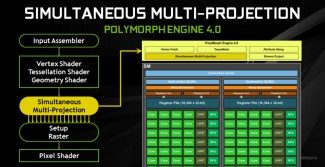
We were expecting VR Funhouse to be a showcase not just for Nvidia’s suite of physics engines but also their much hyped VR-centric technologies SMP (Simultaneous Multi-projection), LMS (Lens Matched Shading) and MRS (Multi-res shading). Unfortunately, it appears only one of these related technologies has made the cut in VR Funhouse. MRS leverages the hardware accelerated functions of SMP to adjust image detail as it reached your peripheral vision. Put another way, the image rendered to the VR headset exhibits less fidelity the further from your central point of view, meaning less GPU power and (potentially and in theory) more fluid frame rates and lower latency. MRS is apparently enabled in the released version of VR Funhouse, but unfortunately the reviewer copy we had access to had the option to toggle and adjust levels of MRS disabled just as we came to it. So, in theory it’s there and working and if it is, it’s incredibly subtle as I couldn’t detect its presence at all. We’ll try to uncover some detail here and will update the piece accordingly.
VR SLI, Nvidia’s dual-GPU (one card per eye) performance scaling system is supposedly present in VR Funhouse too, although we didn’t have the hardware available to test this. You can find out more about VR SLI, MRS as well as other GameWorks technology in our feature piece here. We’ll also have a performance shoot-out with all cards in the new Pascal range soon.
VR is More Fun With Physics
So yes, VR Funhouse is a colourful, elaborate tech demo dressed up as a circus act. But despite this abundance of technology, Nvidia have managed to harness what makes virtual reality delivered using room scale VR and motion controllers so innately fun. When you boil VR Funhouse‘s mechanics down, there’s barely enough here to embarrass a bog standard, freebie mobile game. But presence through VR sells the illusion in such a way as to coax out the playful and mischievous centres of your brain, that you enjoy these interactions on a level comparable to real life. To put it another way; tapping a mobile phone screen to destroy objects engages you in a distant, separated manner, but using your arms to swing at those same objects in 3D space with a realistically modelled sword mapped 1:1 to your physical actions with your senses enveloped triggers feelings altogether more powerful – fun on a different level if you will.
This is all impressive stuff and where the levels of realistic fidelity pushed in historical technical demos often come across as needless, showy overkill – especially when set against a use case of flat screen gaming – in VR this stuff really matters. When you poke a balloon with a sword in VR, it’s important that your physical in-game actions (indelibly linked to your lifetime store of real world expectations) behaves as you’d expect. Not only does it allow a more potent sense of presence, it’s flat out more enjoyable.
The one lingering question here is of proprietary technology of course. Everything you see in VR Funhouse is built with Nvidia specific features in mind. Therefore, if we’re to enjoy the kinds of presence enhancing physics on show beyond Funhouse, developers will need to code specifically for Gameworks. This means that, unless those same developers adopt equivalent APIs from AMD, some players will inevitably be left out in the cold. We’re very much hoping to dig deeper into Nvidia’s biggest rival’s GPU and VR API offerings soon in any case.
So, will you spend vast amounts of time tinkering inside Nvidia’s newest box of GPU powered tricks discovering myriad gameplay nuances? No, you won’t. Will you fire this exemplary VR demonstration of cutting edge physics and rendering up the next time you want to wow your VR newbie friends? Absolutely. And after spending time with VR Funhouse, it may even become the first thing you want to show off.
VR Funhouse is available from today for free on Steam.

